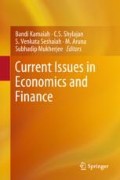Abstract
In this article, we analyze the co-movements of nine Asian Forex markets China, India, Hong Kong, Malaysia, Indonesia, Singapore, Japan, Taiwan, Thailand, and South Korea using bilateral exchange rate against US Dollar from 03-01-2006 to 04-09-2015. We employ a wavelet-based methodology to analyze the extent to with the markets are correlated with each other across different timescales. It is found that the markets are moderately correlated at the intra-week scale and the extent of correlation increases with the increase in timescale. Near-perfect cointegration among the analyzed markets is found across annual–biannual timescale. The cross-correlation analysis shows that Singapore Forex market may lead the other Forex markets of the group across timescales from 16 to 64 days. Results indicate that there is a possibility of intervention as well as potential for portfolio diversification for the short term.
Access this chapter
Tax calculation will be finalised at checkout
Purchases are for personal use only
References
Ahmad, R., Rhee, S. G., & Wong, Y. M. (2012). Foreign exchange market efficiency under recent crises: Asia-Pacific focus. Journal of International Money and Finance, 31(6), 1574–1592. doi:10.1016/j.jimonfin.2012.02.016.
Aroskar, R., Sarkar, S. K., & Swanson, P. E. (2004). European foreign exchange market efficiency: Evidence based on crisis and non-crisis periods. International Review of Financial Analysis, 13(3), 333–347.
AuYong, H. H., Gan, C., & Treepongkaruna, S. (2004). Cointegration and causality in the Asian and emerging foreign exchange markets: Evidence from the 1990s financial crises. International Review of Financial Analysis, 13, 479–515. doi:10.1016/j.irfa.2004.02.024.
Baillie, R. T., & Bollerslev, T. (1989). Common stochastic trends in a system of exchange rates. The Journal of Finance, 44(1), 167–181.
Bohdalova, M., & Grigus, M. (2014). Cointegration analysis of the foreign exchange rate pairs. In BTU conference on innovation, technology transfer and education (pp. 147–153).
Chaudhry, S. A., & Javid, A. Y. (2012). Efficiency of the foreign exchange markets of South Asian countries. Pakistan Institute of Development Studies, Working Paper 82.
Fernández-Macho, J. (2012). Wavelet multiple correlation and cross-correlation: A multiscale analysis of Eurozone stock markets. Physica A: Statistical Mechanics and its Applications, 391(4), 1097–1104. doi:10.1016/j.physa.2011.11.002.
Fisher, E. A. (1921). On the “probable error” of a coefficient of correlation deduced from a small sample. Metron, 11, 3–32.
Jeon, B. N., & Lee, E. (2002). Foreign exchange market efficiency, cointegration, and policy coordination. Applied Economics Letters, 9(1), 61–68.
Johnson, N. L., Kotz, S., & Balakrishnan, N. (1995). Continuous univariate distributions (Vol. 2). New York: Wiley.
Phengpis, C. (2006). Market efficiency and cointegration of spot exchange rates during periods of economic turmoil: Another look at European and Asian currency crises. Journal of Economics and Business, 58(4), 323–342. doi:10.1016/j.jeconbus.2005.10.003.
Phengpis, C., & Nguyen, V. (2009). Policy coordination and risk premium in foreign exchange markets for major EU currencies. Journal of International Financial Markets, Institutions and Money, 19(1), 47–62.
Rapp, T. A., & Sharma, S. (1999). Exchange rate market efficiency: Across and within countries. Journal of Economics and Business, 51(5), 423–439.
Author information
Authors and Affiliations
Corresponding author
Editor information
Editors and Affiliations
Rights and permissions
Copyright information
© 2017 Springer Nature Singapore Pte Ltd.
About this chapter
Cite this chapter
Kumar, A.S., Kamaiah, B. (2017). Co-movement Among Asian Forex Markets: Evidence from Wavelet Methods. In: Kamaiah, B., Shylajan, C., Seshaiah, S., Aruna, M., Mukherjee, S. (eds) Current Issues in Economics and Finance. Springer, Singapore. https://doi.org/10.1007/978-981-10-5810-3_4
Download citation
DOI: https://doi.org/10.1007/978-981-10-5810-3_4
Published:
Publisher Name: Springer, Singapore
Print ISBN: 978-981-10-5809-7
Online ISBN: 978-981-10-5810-3
eBook Packages: Economics and FinanceEconomics and Finance (R0)

